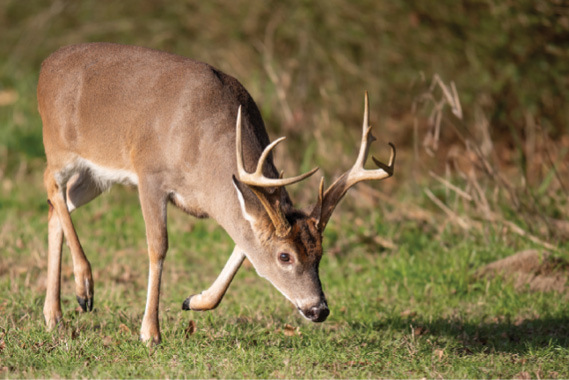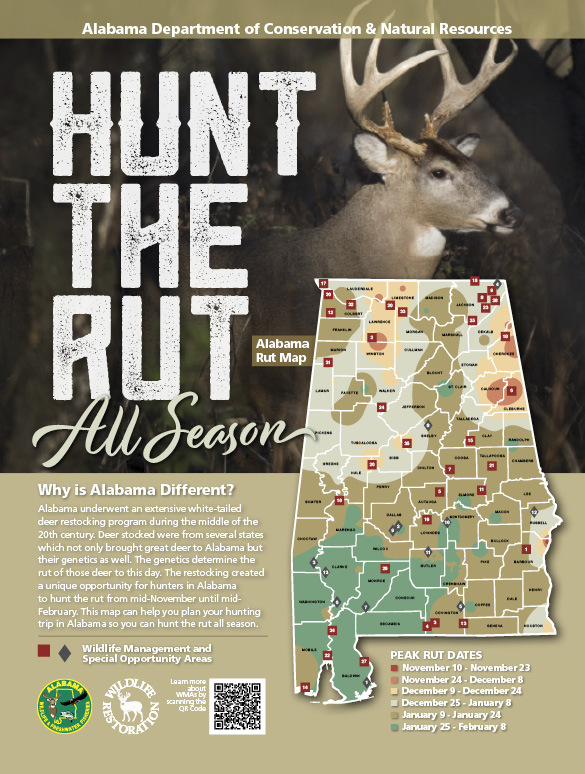The Alabama Rut

As most of Alabama’s deer hunters know, the white-tailed deer rut in Alabama varies considerably from one area of the state to another. There are often variations of several weeks or more among regions within a single county. To enable hunters to better track when and where deer should be rutting throughout the deer season, WFF created a rut map which shows the two-week window when the majority of breeding occurs for each region of the state. Data collected from 282 sites in 66 counties by WFF’s Wildlife Section staff beginning in 1995 were used to develop this useful reference for hunters. This required many, many hours in the field examining deer and collecting the necessary data.
While not as accurate as other techniques, an alternative approach to identifying peaks in breeding activity within counties comes from monitoring peaks in buck harvests. In most regions of Alabama, peaks in buck harvest typically occur at three times during the season — opening week of the gun stalk hunting season, the week between Christmas and New Year’s Day, and the rut. By using buck harvest data collected through Game Check, peaks in rut-related activity can be identified in most counties.
Bucks are more susceptible to harvest during opening week of gun season because more hunters are afield than at any other time of the season. Bucks also have not been exposed to hunting pressure and the associated disturbances. Once deer season opens, deer quickly respond to these pressures and their activity levels can change significantly — almost overnight. This is usually most pronounced in mature deer. This “opening day effect” is obvious when looking at the opening weekend harvests for practically every county in Alabama. A second peak for buck harvests in many counties occurs between Christmas and New Year’s Day. This again is due primarily to a sharp increase in the number of hunters out hunting.
Surges in buck harvests occurring outside of opening week of gun season and the Christmas-New Year’s Day holiday week are most often associated with increased movements associated with the rut. As the rut approaches and opportunities to breed near, the wiliest of mature bucks become susceptible to making “young deer” mistakes. Buck movements associated with the rut typically reach their peak about one week to 10 days prior to the peak of breeding. Bucks are on the move in search of receptive does, but most does are not ready to breed at that time. This means bucks are spending a great deal of time moving from doe group to doe group looking for receptive does. As a result, increases in buck harvest usually occur at that time because bucks are more exposed and vulnerable to harvest. As more does become receptive and breeding peaks, buck movements tend to slow since they are encountering more does which are ready to breed.
By comparison, doe harvests almost always peak when hunter numbers are at their highest — opening week of gun stalk season and the week between Christmas and New Year’s Day. Other peaks in doe harvest often occur at the end of season as hunters scramble to get at least one deer in the freezer before the season closes — also known as the “I’m running out of time” effect.
Figure 1 illustrates how peak breeding within a county can be estimated by looking at peaks in buck harvests. The graph shows the combined weekly buck harvest for Dallas County from the 2021–22 and 2022–23 gun deer seasons. The orange bars are harvests for the opening week of gun season and the week between Christmas and New Year’s Day — periods when harvests typically spike due to reasons highlighted earlier. Buck harvests tailed off quickly following the opening week of season and did not jump again until the period between January 14 and January 28. Harvests steadily declined until the last week of season February 4–10. Buck harvest bumped up slightly during the last week of season. This was most likely due to the “I’m running out of time” effect.

Conception date data were collected from nine locations scattered throughout Dallas County from 1997 through 2019. Average conception dates ranged from January 21 to February 4 among the sites, but the average for the entire county was January 25. This follows right along with the increased buck harvest during the 7–10 day window prior to that date.
Deer hunters are always looking for that extra edge that will tip the scales in their favor. Two keys to being a successful deer hunter are having the knowledge to understand what is happening at any given time within the deer population being hunted (e.g., what are they eating, rut timing) and understanding when to take advantage of this knowledge. A deer’s diet can and does change throughout the hunting season, so obtaining that key bit of information often takes quite a bit of effort. Knowing when they breed is a little less complicated since it occurs at roughly the same time each year. By knowing what to look for while in the field, as well as knowing how to use the various tools available online such as Alabama’s Rut Map and harvest trends as reported in Game Check, Alabama’s deer hunters can definitely improve their chances of having a successful season in years to come.


